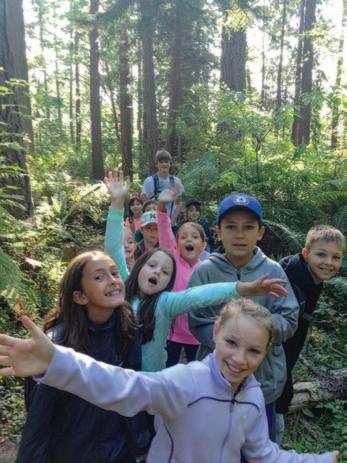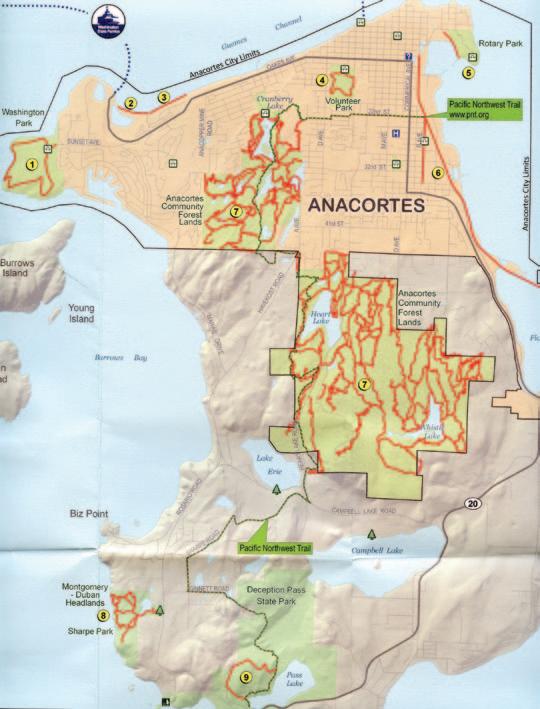
6 minute read
The Friends of the Forest
Putting the Community in the Community Forest
Story by William Dietrich
Sometimes the most effective conservation occurs close to home. Parks, greenbelts, and Land Trust conservation easements are encouraging examples. So is the four-decade-long quest by a citizen’s organization known as Friends of the Forest to protect more than 2,000 acres adjacent to Anacortes.
It’s a woods and lakes mecca that has become a recreational refuge during Covid-19. The community lands are a marvel of conifers, maple, and alder. There are quiet lakes and plenty of wildlife: deer and river otters, osprey and owls. Bald knobs bloom with wildflowers in the spring. Lily pads blossom in beaver ponds.
The preserve gives the Fidalgo Island city one of best ratios of forest-to-population in the nation. And thanks to internet publicity, it increasingly draws visitors from five counties, including the population centers to the south.
At the base of Mount Erie—the prominent 1,273-foot peak that crowns Anacortes Community Forest Lands—the number of parked cars increased about 150 percent in 2020 compared to previous years, said Assistant Parks Director Bob Vaux. With the pandemic keeping recreationists closer to home, the preserve has become a microcosm of forest issues nationwide. It is avidly used not just by hikers but by bikers, horse riders, paddle boarders, the occasional motorcyclist, and legions of dog-walkers.
History
This community crown jewel didn’t just happen. Early city watershed lands were supplemented by decades of generous land donations. The result is two big blocks of woods that stretch from Mount Erie north almost to Guemes Channel and encompass Whistle, Heart, and Little Cranberry Lakes. More than fifty miles of trails wind through the mostly second-growth forest, which also has a few stands of old growth.
It was when the community became alarmed at city clearcutting in the 1980s that Friends of the Forest formed to halt logging, promote more forest acquisition, and spearhead a donation program to buy permanent conservation easements from the city at the rate of $1,000 an acre. What was expected to be a 20-year campaign took less than half that, with 1,800 acres now under easement held by Skagit Land Trust. The nearly $2 million raised is a permanent endowment, with interest used for further acquisitions and care.

Forest Discovery Day Camp.
Photo courtesy of Friends of the Forest
The Friends decided it wasn’t enough to preserve the forest. The trees needed an educated constituency, so the organization began conducting classes and hikes for children and adults to create a cadre of conservationists.
For many years the forest educator was Denise Crowe, an early leader of the protection effort. Now a younger generation serves as paid staff, funded by donations to the Friends. Asa Deane is Executive Director and Beck Pittman is the new Forest Educator. Both have backgrounds in environmental education.
Friends of the Forest works closely with the Anacortes Parks Department and the city’s Forest Advisory Board, which are responsible for forest management, trail repair, and regulation. The goal is to balance access with protection and enhancement.
City ownership began way back in 1919 when Anacortes acquired watershed lands around Little Cranberry and Whistle Lakes, paying $135,000 to Washington Power and Light Company. Gus Hensler donated 120 more acres at the Mount Erie summit in 1934, the first of a series of bequests that have continued into the 21st Century.
Yet the forest was still something of a city afterthought until condominiums were proposed in 1977 at Heart Lake, which was then managed by the state Department of Natural Resources. Environmentalists mobilized and in 1980 the DNR property became an undeveloped state park. Those 436 acres were transferred to city ownership in 2002.

A forest tour circa 1900.
Photo courtesy of Friends of the Forest
The legacy of logging in Skagit County has deep roots. Most of Fidalgo Island had already been logged by 1900. With Anacortes tapping the Skagit River for its water supply, the city began revenue logging of its second growth watershed in the 1940s. By the 1980s, selective cutting wasn’t turning a profit, so managers turned to clearcutting, removing 1.2 million board feet of timber from 1987 to 1989.
In response, Friends of the Forest was formed in 1987. The founders rallied the community to halt the logging and launch an education program. The tiny all-volunteer organization eventually raised enough money to hire Crowe as an educator. Friends helped convince the City Council to adopt the conservation easement program in 1998. Today’s all-volunteer board of directors is working to expand and further professionalize the organization.
Challenges
The community forest lands remain a little paradise. But managers wrestle with fire, drought, invasive species, abutting subdivisions, a rock and gravel mine, and lakes that can be choked with milfoil and algae. Challenges are growing. “There’s not a user group out there that doesn’t have an impact,” said the city’s Vaux.
Most problematic are dogs. Too many forest users ignore rules to keep their animals on leash and clean up their poop. Dog feces inject bacteria and viruses into the ecosystem, just as human waste does. Unleashed dogs can frighten other hikers, chase animals, and blunder into yellow jacket nests and brambles, or fall off cliffs. Leave your dog at home or, if you must, keep it leashed and leave no trace after it does its business.

Big Beaver Pond.
Photo courtesy of Friends of the Forest
The popularity of mountain biking has accelerated trail erosion. In 2019 the city proposed that a former dump site at the edge of the forest, now capped with a meadow, become a 1.5-acre bike skills park with a track for beginners. Over 80 young cyclists packed a City Council meeting in support, but protest erupted over concentrated recreational development. The project is now on hold while the state Department of Ecology tests the landfill for potential leakage of contaminants.
Horses churn mud and leave manure. Motorcycles, which are still allowed in summer months, damage trails too. The city was trying to come up with a policy on e-bikes when Covid-19 hit, postponing a resolution.

Anacortes Community Forest Trails.
Courtesy of Friends of the Forest
A few people, sometimes homeless, build fires or shelters. There was a small forest fire at the Orange Wall of Mount Erie in July of 2020. A 17.6-acre fire at Little Cranberry Lake in 2016 burned toward houses before it was stopped by fire crews.
Climate change is a broader issue. The forest has suffered drought for several years, resulting in a large die-off of young cedar trees. The same heat has warmed the lakes and led to more weeds. Heart Lake was expensively and successfully treated, but the fix is probably temporary.
Adjacent to the lake is a rock and gravel pit run by Lakeside Industries. While city revenue from the pit has been used to help pay for forest acquisitions and education, the mine stretches for a kilometer: a distance as long as the whole of downtown Anacortes from Guemes Channel to the Safeway at 12th Street.
Even with resource royalties, needed improvements are slow to happen. The city has had a plan to redo the ugly gravel parking lot at Heart Lake and build a trail along Heart Lake Road since 2009. It hasn’t been able to find the money.
Faced with all these challenges, Friends is charging into the future with a renewed commitment to partnership with Anacortes schools, guided hikes, and both printed and social media information. The hope is that 2021 classes will be less restricted by the pandemic—and that forests recreationists become forest stewards.
ANW
William Dietrich is a journalist and author who serves on the Friends of the Forest Board of Directors.
Education, Advocacy, Stewardship; Learn More
Learn more about The Friends of the Forest (and support them with a donation) at www.friendsoftheacfl.org. Downloadable maps, available there and at www.cityofanacortes.org, help visitors navigate the network of trails found on the Anacortes Community Forest Lands.






